Synthesis and Characterization of Novel 2-(1,2,3-Triazol-4-yl)-4,5-dihydro-1H-pyrazol-1-yl)thiazoles and 2-(4,5-Dihydro-1H-pyrazol-1-yl)-4-(1H-1,2,3-triazol-4-yl)thiazoles
Abstract
1. Introduction
2. Results and Discussion
Synthesis of Novel Heterocycles
3. Materials and Methods
3.1. General
3.2. Synthesis of Chalcones 3a,b
3.2.1. (E)-3-(4-Methoxyphenyl)-1-(5-methyl-1-phenyl-1H-1,2,3-Triazol-4-yl)prop-2-en-1-one (3a)
3.2.2. (E)-3-(4-Fluorophenyl)-1-(1-(4-fluorophenyl)-5-methyl-1H-1,2,3-triazol-4-yl)prop-2-en-1-one (3b)
3.3. Synthesis of Pyrazolin-N-Thioamides 4a,b
3.3.1. 5-(4-Methoxyphenyl)-3-(5-methyl-1-phenyl-1H-1,2,3-triazol-4-yl)-4,5-dihydro-1H-pyrazole-1-carbothioamide (4a)
3.3.2. 5-(4-Fluorophenyl)-3-(1-(4-fluorophenyl)-5-methyl-1H-1,2,3-triazol-4-yl)-4,5-dihydro-1H-pyrazole-1-carbothioamide (4b)
3.4. Synthesis of Compounds 8–10
3.4.1. Ethyl 2-(5-(4-Methoxyphenyl)-3-(5-methyl-1-phenyl-1H-1,2,3-triazol-4-yl)-4,5-dihydro-1H-pyrazol-1-yl)-4-methylthiazole-5-carboxylate (8)
3.4.2. 4-(Benzofuran-2-yl)-2-(5-(4-fluorophenyl)-3-(1-(4-fluorophenyl)-5-methyl-1H-1,2,3-triazol-4-yl)-4,5-dihydro-1H-pyrazol-1-yl)thiazole (9)
3.4.3. 2-(5-(4-Fluorophenyl)-3-(1-(4-fluorophenyl)-5-methyl-1H-1,2,3-triazol-4-yl)-4,5-dihydro-1H-pyrazol-1-yl)-5-((4-fluorophenyl)diazenyl)-4-methylthiazole (10)
3.5. Synthesis of Compounds 13–15
3.5.1. 2-(3-(4-Chlorophenyl)-5-(4-fluorophenyl)-4,5-dihydro-1H-pyrazol-1-yl)-4-(5-methyl-1-phenyl-1H-1,2,3-triazol-4-yl)thiazole (13)
3.5.2. 2-(3-(4-Chlorophenyl)-5-(4-fluorophenyl)-4,5-dihydro-1H-pyrazol-1-yl)-4-(5-methyl-1-(4-tolyl)-1H-1,2,3-triazol-4-yl)thiazole (14)
3.5.3. 2-(5-(4-Fluorophenyl)-3-(4-methoxyphenyl)-4,5-dihydro-1H-pyrazol-1-yl)-4-(5-methyl-1-(4-nitrophenyl)-1H-1,2,3-triazol-4-yl)thiazole (15)
3.6. Crystal Structure Determination
4. Conclusions
Supplementary Materials
Author Contributions
Funding
Institutional Review Board Statement
Informed Consent Statement
Data Availability Statement
Acknowledgments
Conflicts of Interest
Sample Availability
References
- Sharma, P.K.; Amin, A.; Kumar, M. A review: Medicinally important nitrogen sulphur containing heterocycles. Open Med. Chem. J. 2020, 14, 49–64. [Google Scholar] [CrossRef]
- De, S.; Aamna, B.; Sahu, R.; Parida, S.; Behera, S.K.; Dan, A.K. Seeking heterocyclic scaffolds as antivirals against dengue virus. Eur. J. Med. Chem. 2022, 240, 114576. [Google Scholar] [CrossRef] [PubMed]
- Karrouchi, K.; Radi, S.; Ramli, Y.; Taoufik, J.; Mabkhot, Y.N.; Al-aizari, F.A.; Ansar, M. Synthesis and pharmacological activities of pyrazole derivatives: A review. Molecules 2018, 23, 134. [Google Scholar] [CrossRef] [PubMed]
- Ebenezer, O.; Shapi, M.; Tuszynski, J.A. A review of the recent development in the synthesis and biological evaluations of pyrazole derivatives. Biomedicines 2022, 10, 1124. [Google Scholar] [CrossRef]
- Naim, M.J.; Alam, O.; Nawaz, F.; Alam, M.J.; Alam, P. Current status of pyrazole and its biological activities. J. Pharm. Bioallied. Sci. 2016, 8, 2–17. [Google Scholar] [CrossRef]
- Chhabria, M.T.; Patel, S.; Modi, P.; Brahmkshatriya, P.S. Thiazole: A review on chemistry, synthesis and therapeutic importance of its derivatives. Curr. Top. Med. Chem. 2016, 16, 2841–2862. [Google Scholar] [CrossRef]
- Nayak, S.; Gaonkar, S.L. A review on recent synthetic strategies and pharmacological importance of 1,3-thiazole derivatives. Mini Rev. Med. Chem. 2019, 19, 215–238. [Google Scholar] [CrossRef]
- Leoni, A.; Locatelli, A.; Morigi, R.; Rambaldi, M. Novel thiazole derivatives: A patent review (2008–2012; Part 1). Expert. Opin. Ther. Pat. 2014, 24, 201–216. [Google Scholar] [CrossRef]
- Alia, S.H.; Sayed, A.R. Review of the synthesis and biological activity of thiazoles. Synth. Commun. 2021, 51, 670–700. [Google Scholar] [CrossRef]
- 1Akter, M.; Rupa, K.; Anbarasan, P. 1,2,3-Triazole and its analogues: New surrogates for diazo compounds. Chem. Rev. 2022, 122, 13108–13205. [Google Scholar] [CrossRef]
- Alam, M.M. 1,2,3-Triazole hybrids as anticancer agents: A review. Arch. Pharm. 2022, 355, e2100158. [Google Scholar] [CrossRef] [PubMed]
- 1Wen, X.; Zhou, Y.; Zeng, J.; Liu, X. Recent development of 1,2,4-triazole-containing compounds as anticancer agents. Curr. Top. Med. Chem. 2020, 20, 1441–1460. [Google Scholar] [CrossRef]
- Bozorov, K.; Zhao, J.; Aisa, H.A. 1,2,3-Triazole-containing hybrids as leads in medicinal chemistry: A recent overview. Bioorg. Med. Chem. 2019, 27, 3511–3531. [Google Scholar] [CrossRef]
- Thabit, T.M.A.; Abdelkareem, E.M.; Bouqellah, N.A.; Shokr, S.A. Triazole fungicide residues and their inhibitory effect on some trichothecenes mycotoxin excretion in wheat grains. Molecules 2021, 26, 1784. [Google Scholar] [CrossRef] [PubMed]
- Ijaz, M.; Ul-Allah, S.; Sher, A.; Sattar, A.; Ahmad, W.; Rehim, A.; Honermeier, B. Chapter 19—Effects of triazoles, strobilurins, and trinexapac ethyl on growth and development of crop plants under stress conditions. J. Plant Growth Regul. 2022, 423–428. [Google Scholar] [CrossRef]
- Yi, F.; Zhao, W.; Wang, Z.; Bi, X. Silver-mediated [3 + 2] cycloaddition of alkynes and N-isocyanoiminotriphenylphosphorane: Access to monosubstituted pyrazoles. Org. Lett. 2019, 21, 3158–3161. [Google Scholar] [CrossRef]
- Lellek, V.; Chen, C.-Y.; Yang, W.; Liu, J.; Ji, X.; Faessler, R. An efficient synthesis of substituted pyrazoles from one-pot reaction of ketones, aldehydes, and hydrazine monohydrochloride. Synlett 2018, 29, 1071–1075. [Google Scholar] [CrossRef]
- Fan, Z.; Feng, J.; Hou, Y.; Rao, M.; Cheng, J. Copper-catalyzed aerobic cyclization of β,γ-unsaturated hydrazones with concomitant C═C bond cleavage. Org. Lett. 2020, 22, 7981–7985. [Google Scholar] [CrossRef]
- Guo, H.; Tian, L.; Liu, Y.; Wan, J.-P. DMSO as a C1 source for [2 + 2 + 1] pyrazole ring construction via metal-free annulation with enaminones and hydrazines. Org. Lett. 2022, 24, 228–233. [Google Scholar] [CrossRef]
- Wang, X.; Qiu, X.; Wei, J.; Liu, J.; Song, S.; Wang, W.; Jiao, N. Cu-catalyzed aerobic oxidative sulfuration/annulation approach to thiazoles via multiple Csp3–H bond cleavage. Org. Lett. 2018, 20, 2632–2636. [Google Scholar] [CrossRef]
- Ma, X.; Yu, X.; Huang, H.; Zhou, Y.; Song, Q. Synthesis of thiazoles and isothiazoles via three-component reaction of enaminoesters, sulfur, and bromodifluoroacetamides/esters. Org. Lett. 2020, 22, 5284–5288. [Google Scholar] [CrossRef] [PubMed]
- Zhu, Y.; Chen, W.; Zhao, D.; Zhang, G.; Yu, Y. One-pot three-component strategy for polysubstituted 2-aminothiazoles via ring opening of α-nitro epoxides. Synthesis 2019, 51, 2023–2029. [Google Scholar] [CrossRef]
- Kiran, K.R.; Swaroop, T.R.; Rajeev, N.; Anil, S.M.; Rangappa, J.S.; Sadashiva, M.P. Cyclization of active methylene isocyanides with α-oxodithioesters induced by base: An expedient synthesis of 4-methylthio/ethoxycarbonyl-5-acylthiazoles. Synthesis 2020, 52, 1103–1112. [Google Scholar] [CrossRef]
- Shu, W.-M.; Zhang, X.-F.; Zhang, X.-X.; Li, M.; Wang, A.-J.; Wu, A.-X. Metal-free cascade [4 + 1] cyclization access to 4-aryl-NH-1,2,3-triazoles from N-tosylhydrazones and sodium azide. J. Org. Chem. 2019, 84, 14919–14925. [Google Scholar] [CrossRef]
- Huang, C.; Geng, X.; Zhao, P.; Zhou, Y.; Yu, X.-X.; Wang, L.-S.; Wu, Y.-D.; Wu, A.-X. Direct synthesis of 4-aryl-1,2,3-triazoles via I2-promoted cyclization under metal- and azide-free conditions. J. Org. Chem. 2021, 86, 13664–13672. [Google Scholar] [CrossRef] [PubMed]
- Zehnder, L.R.; Hawkins, J.M.; Sutton, S.C. One-pot, metal- and azide-free synthesis of 1,2,3-triazoles from α-ketoacetals and amines. Synlett 2020, 31, 175–178. [Google Scholar] [CrossRef]
- Wang, X.-X.; Xin, Y.; Li, Y.; Xia, W.-J.; Zhou, B.; Ye, R.-R.; Li, Y.-M. Copper-catalyzed decarboxylative cycloaddition of propiolic acids, azides, and arylboronic acids: Construction of fully substituted 1,2,3-triazoles. J. Org. Chem. 2020, 85, 3576–3586. [Google Scholar] [CrossRef]
- Abdel-Wahab, B.F.; Mohamed, H.A.; Farahat, A.A.; Dawood, K.M. Synthetic accesses to azolylthiazoles. Heterocycles 2011, 83, 2731–2767. [Google Scholar] [CrossRef]
- Kariuki, B.M.; Abdel-Wahab, B.F.; El-Hiti, G.A. Synthesis and structural characterization of isostructural 4-(4-aryl)-2-(5-(4-fluorophenyl)-3-(1-(4-fluorophenyl)-5-methyl-1H-1,2,3-triazol-4-yl)-4,5-dihydro-1H-pyrazol-1-yl)thiazoles. Crystals 2021, 11, 795. [Google Scholar] [CrossRef]
- El-Hiti, G.A.; Abdel-Wahab, B.F.; Baashen, M.; Hegazy, A.S.; Kariuki, B.M. Crystal structure of (E)-5-((4-chlorophenyl)diazenyl)-2-(5-(4-fluorophenyl)-3-(thiophen-2-yl)-4,5-dihydro-1H-pyrazol-1-yl)-4-methylthiazole, C23H17ClFN5S2. Z. Für Krist.-New Cryst. Struct. 2017, 232, 157–158. [Google Scholar] [CrossRef]
- Ghabbour, H.A.; Abdel-Wahab, B.F.; Alamri, M.; Al-Omar, M.A.; El-Hiti, G.A. Crystal structure of 2-(5-(4-fluorophenyl)-3-p-tolyl-4,5-dihydro-1H-pyrazol-1-yl)-4-(5-methyl-1-p-tolyl-1H-1,2,3-triazol-4-yl)thiazole, C29H25FN6S. Z. Für Krist.-New Cryst. Struct. 2017, 232, 21–23. [Google Scholar] [CrossRef]
- Mohamed, H.A.; Abdel-Wahab, B.F.; Sabry, E.; Kariuki, B.M.; El-Hiti, G.A. Synthesis and antimicrobial activity of 2,5-bis(pyrazol-3-yl or triazol-4-yl)-1,3,4-oxadiazoles. Heterocycles 2022, 104, 1293–1302. [Google Scholar] [CrossRef]
- Abdel-Wahab, B.F.; Mohamed, H.A.; Farahat, A.A.; Kariuki, B.M.; El-Hiti, G.A. reactivity of 4-bromoacetyl-1,2,3-triazoles towards amines and phenols: Synthesis and antimicrobial activity of novel heterocycles. Heterocycles 2022, 104, 1601–1613. [Google Scholar] [CrossRef]
- Abdel-Wahab, B.F.; Khidre, R.E.; Mohamed, H.A.; El-Hiti, G.A. A simple process for the synthesis of novel pyrazolyltriazole and dihydropyrazolylthiazole derivatives as antimicrobial agents. Arab. J. Sci. Eng. 2017, 42, 2441–2448. [Google Scholar] [CrossRef]
- Kamalraj, V.R.; Senthil, S.; Kannan, P. One-pot synthesis and the fluorescent behavior of 4-acetyl-5-methyl-1,2,3-triazole regioisomers. J. Mol. Struct. 2008, 892, 210–215. [Google Scholar] [CrossRef]
- Shriner, R.L.; Anderson, J. Derivatives of coumaran. VI. Reduction of 2-acetobenzofuran and its derivatives. J. Am. Chem. Soc. 1939, 61, 2705–2708. [Google Scholar] [CrossRef]
- Biere, H.; Schroeder, E.; Ahrens, H.; Kapp, J.F.; Boettcher, I. Non-steroidal antiinflammatory agents. 5. Antiinflammatory pyrazole acetic acids. Eur. J. Med. Chem. 1982, 17, 27–34. [Google Scholar]
- Chimenti, F.; Carradori, S.; Secci, D.; Bolasco, A.; Bizzarri, B.; Chimenti, P.; Granese, A.; Yanez, M.; Orallo, F. Synthesis and inhibitory activity against human monoamine oxidase of N1-thiocarbamoyl-3,5-di(hetero)aryl-4,5-dihydro-(1H)-pyrazole derivatives. Eur. J. Med. Chem. 2010, 45, 800–804. [Google Scholar] [CrossRef]
- Abdel-Wahab, B.F.; Mohamed, H.A.; Ng, S.W.; Tiekink, E.R.T. 3-(4-Chlorophenyl)-5-(4-fluorophenyl)-4,5-dihydro-1H-pyrazole-1-carbothioamide. Acta Cryst. 2013, 69E, o414–o415. [Google Scholar] [CrossRef]
- Bunev, A.S.; Trushkova, Y.O.; Ostapenko, G.I.; Statsyuk, V.E.; Peregudov, A.S. Synthesis of 4-(1H-1,2,3-Triazol-4-yl)-1,3-thiazole-2-amine derivatives. Chem. Heterocycl. Compd. 2014, 50, 1027–1031. [Google Scholar] [CrossRef]
- Sheldrick, G.M. A short history of SHELX. Acta Crystallogr. A 2008, 64, 112–122. [Google Scholar] [CrossRef] [PubMed]
- Sheldrick, G.M. Crystal structure refinement with SHELXL. Acta Crystallogr. C 2015, 71, 3–8. [Google Scholar] [CrossRef] [PubMed]
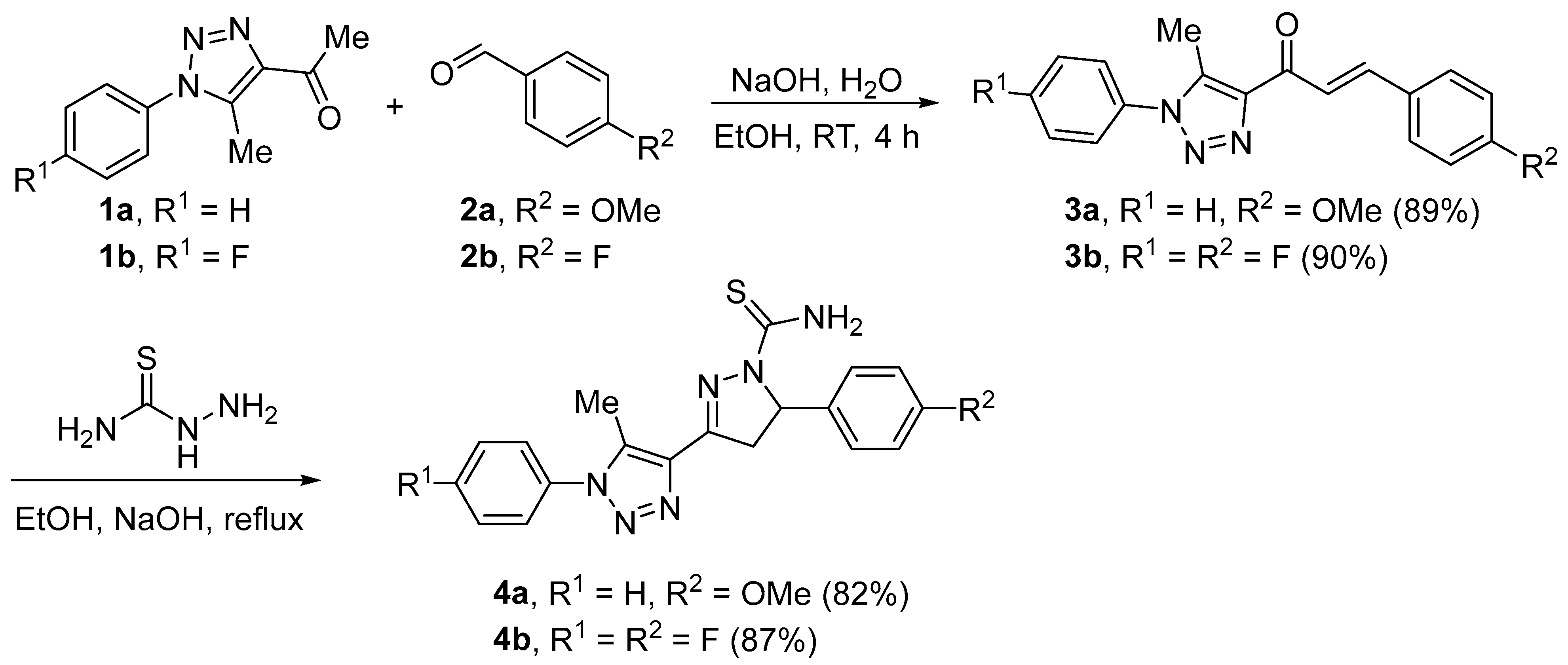
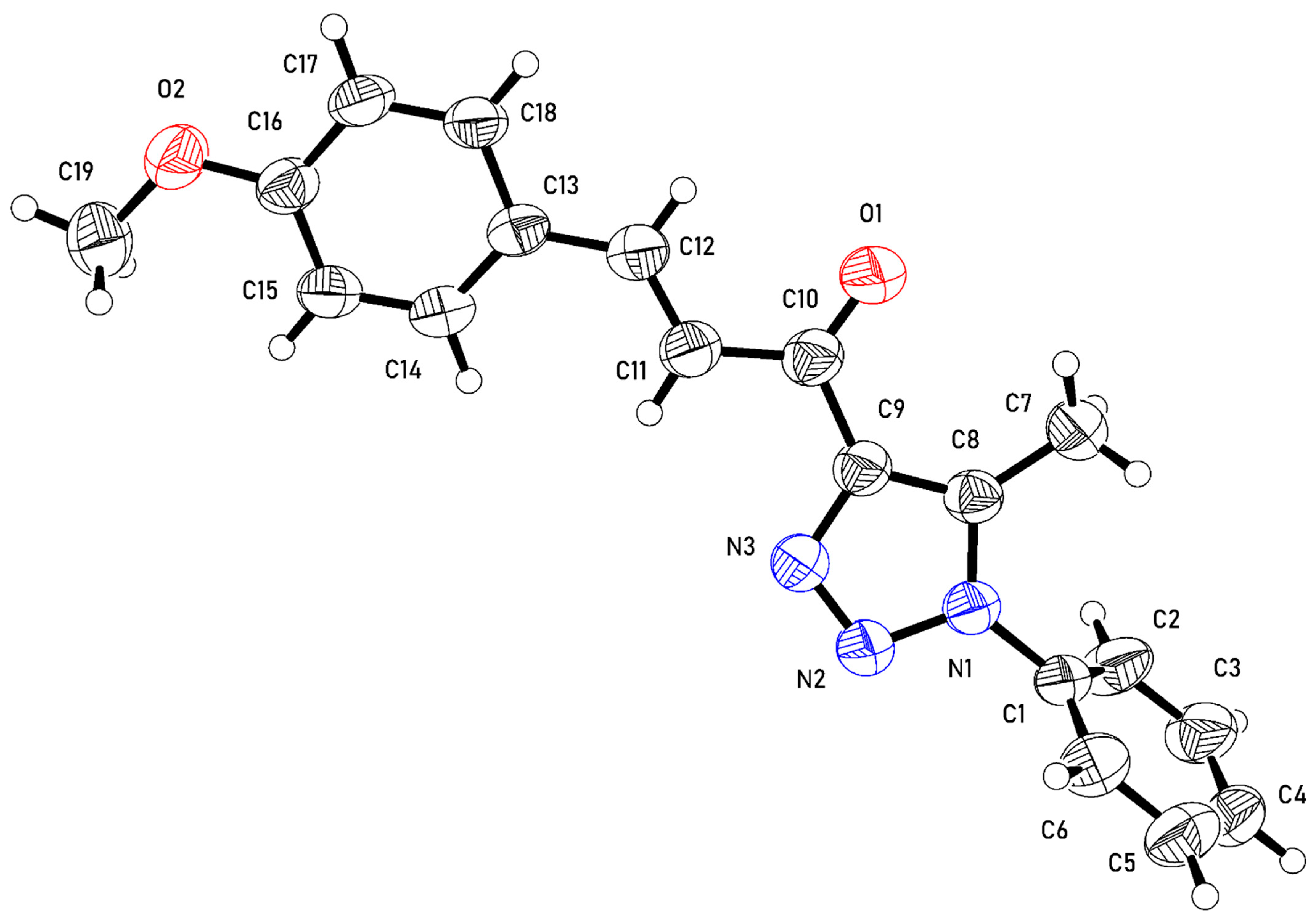
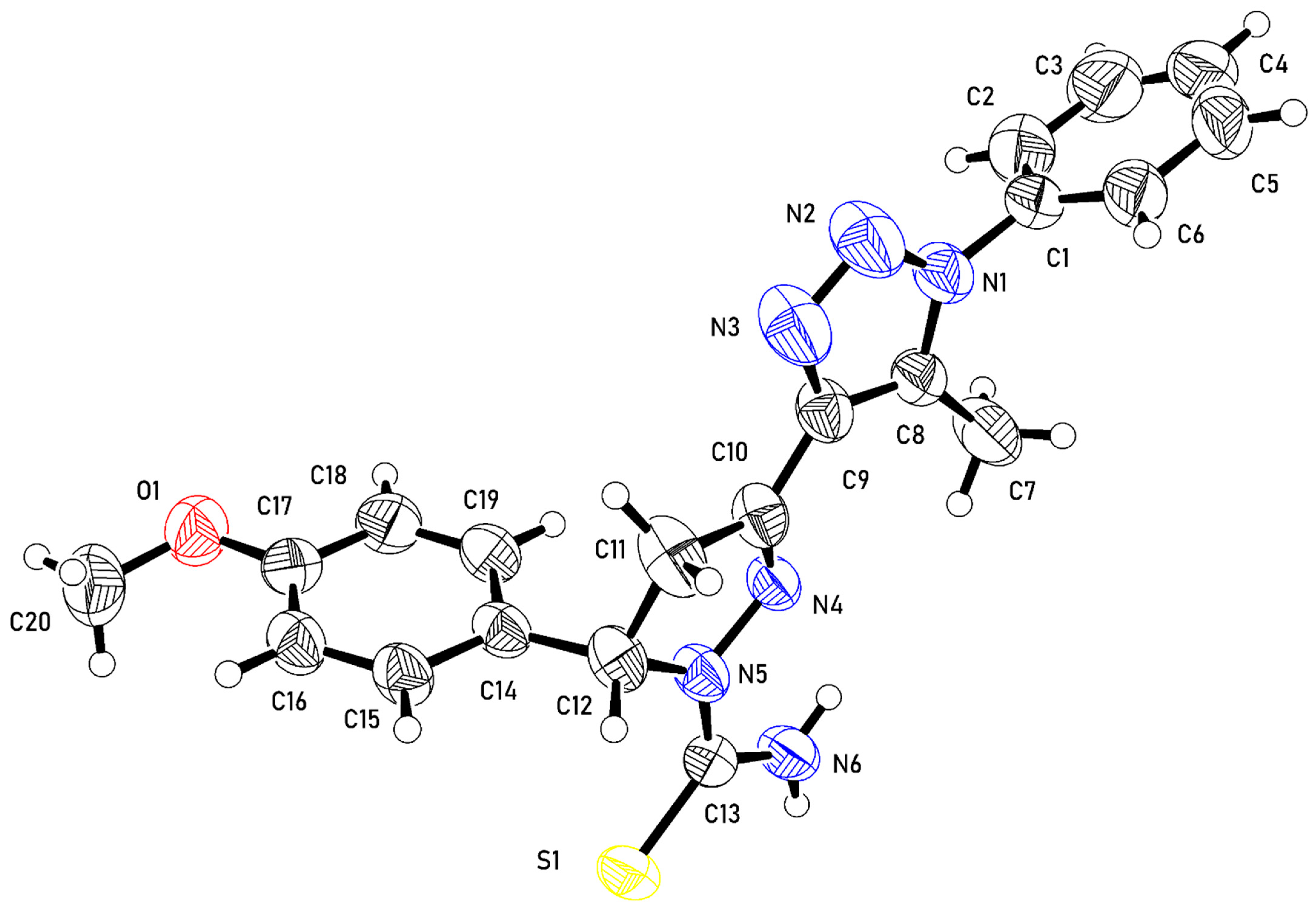
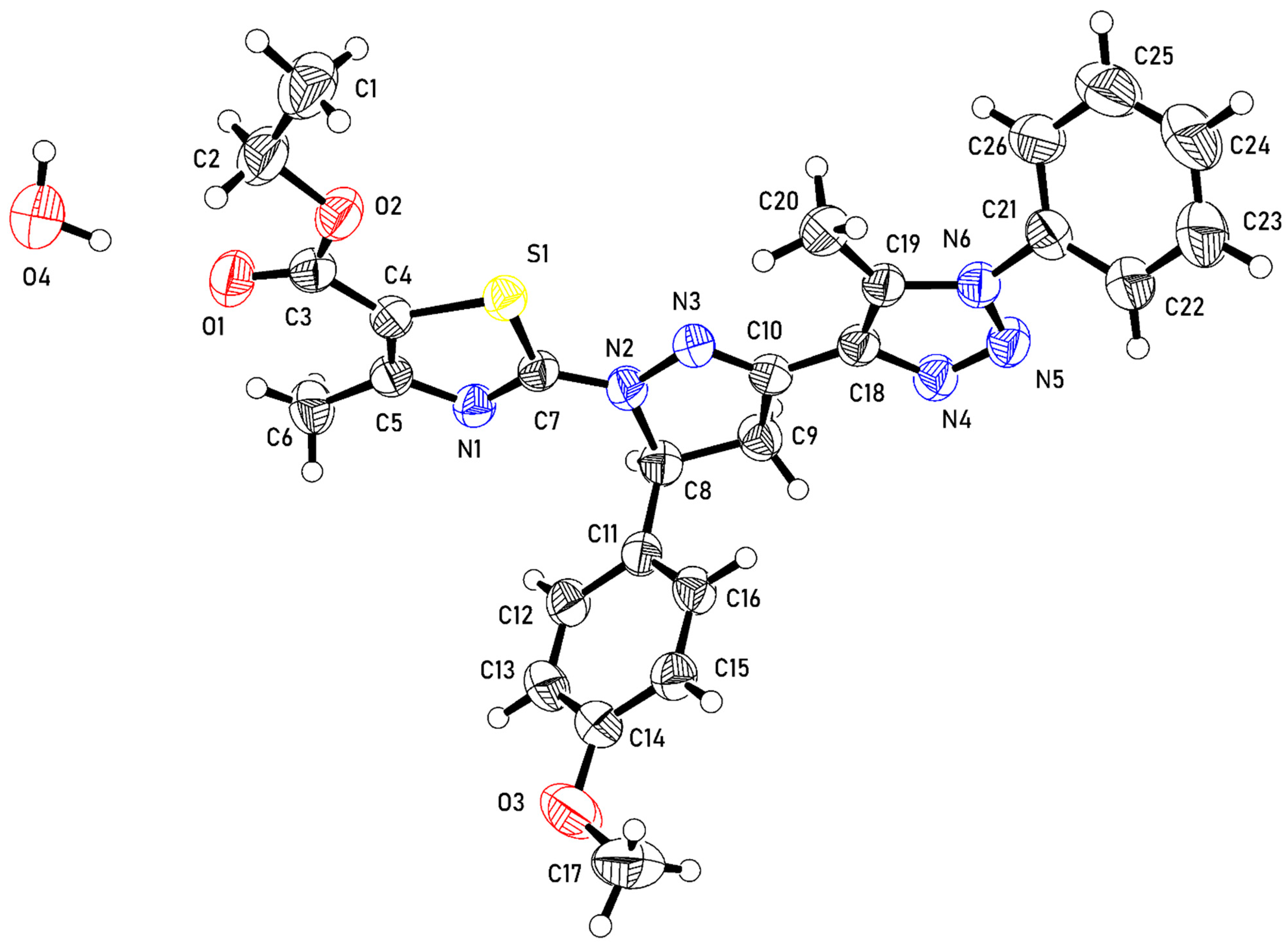
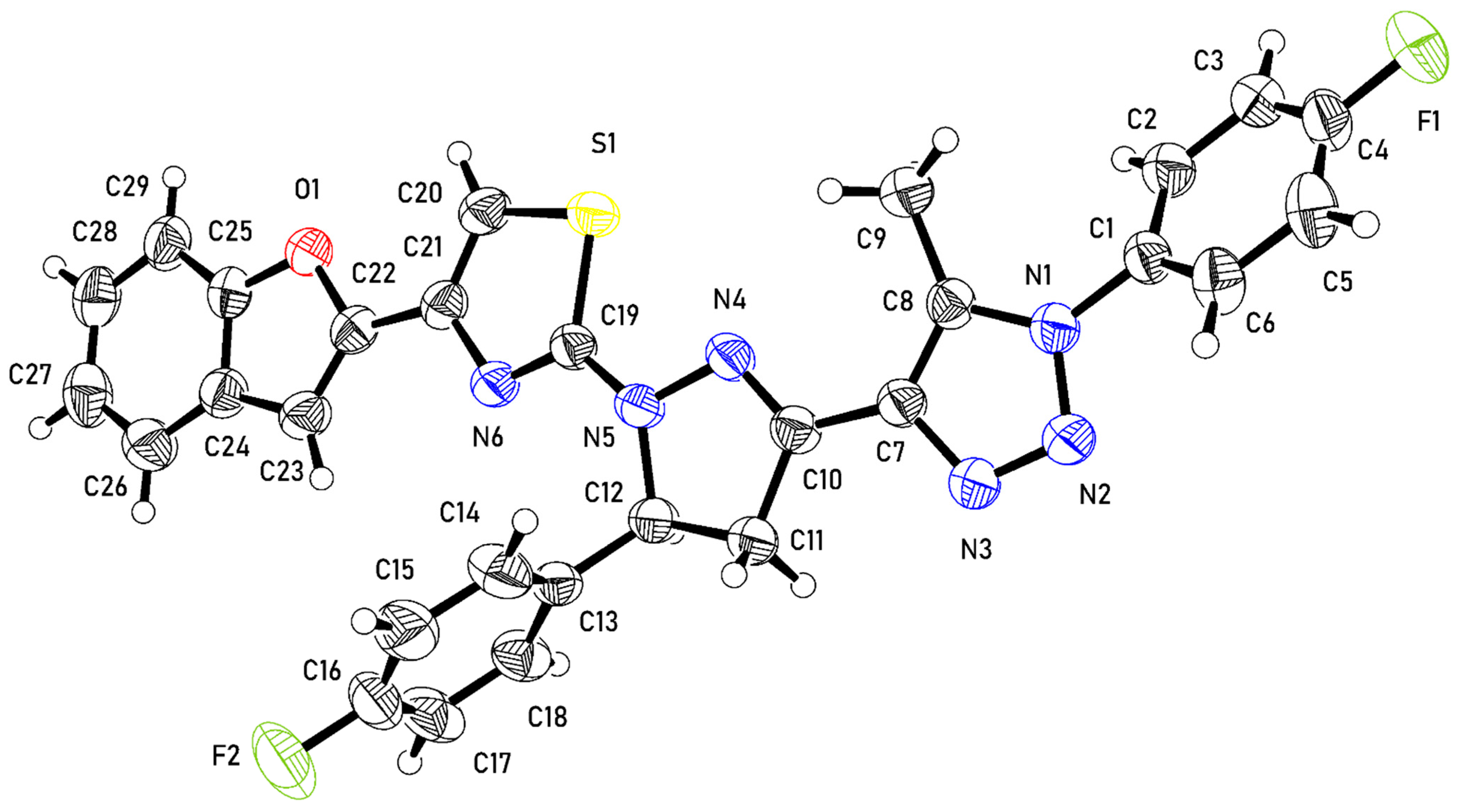
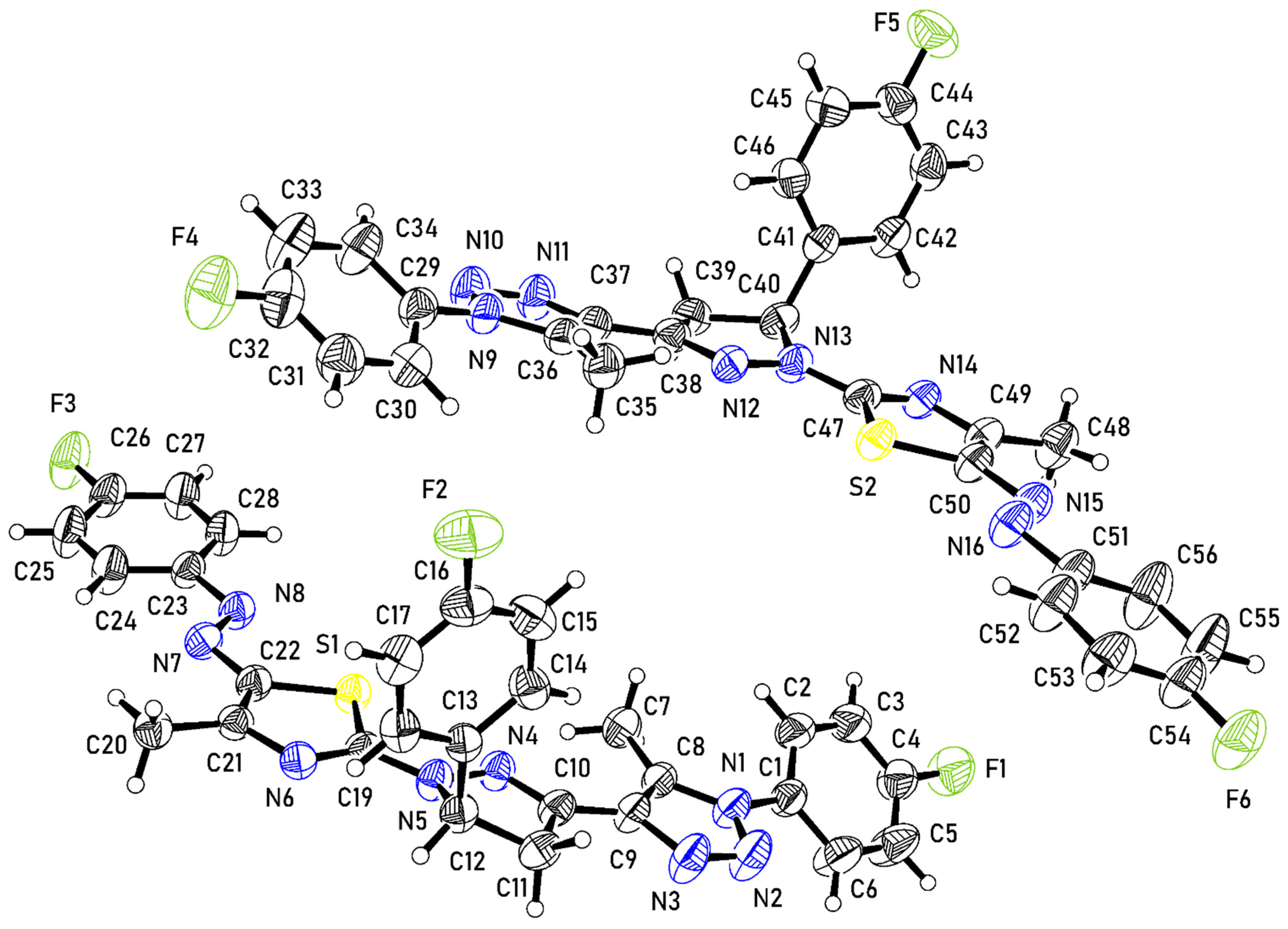
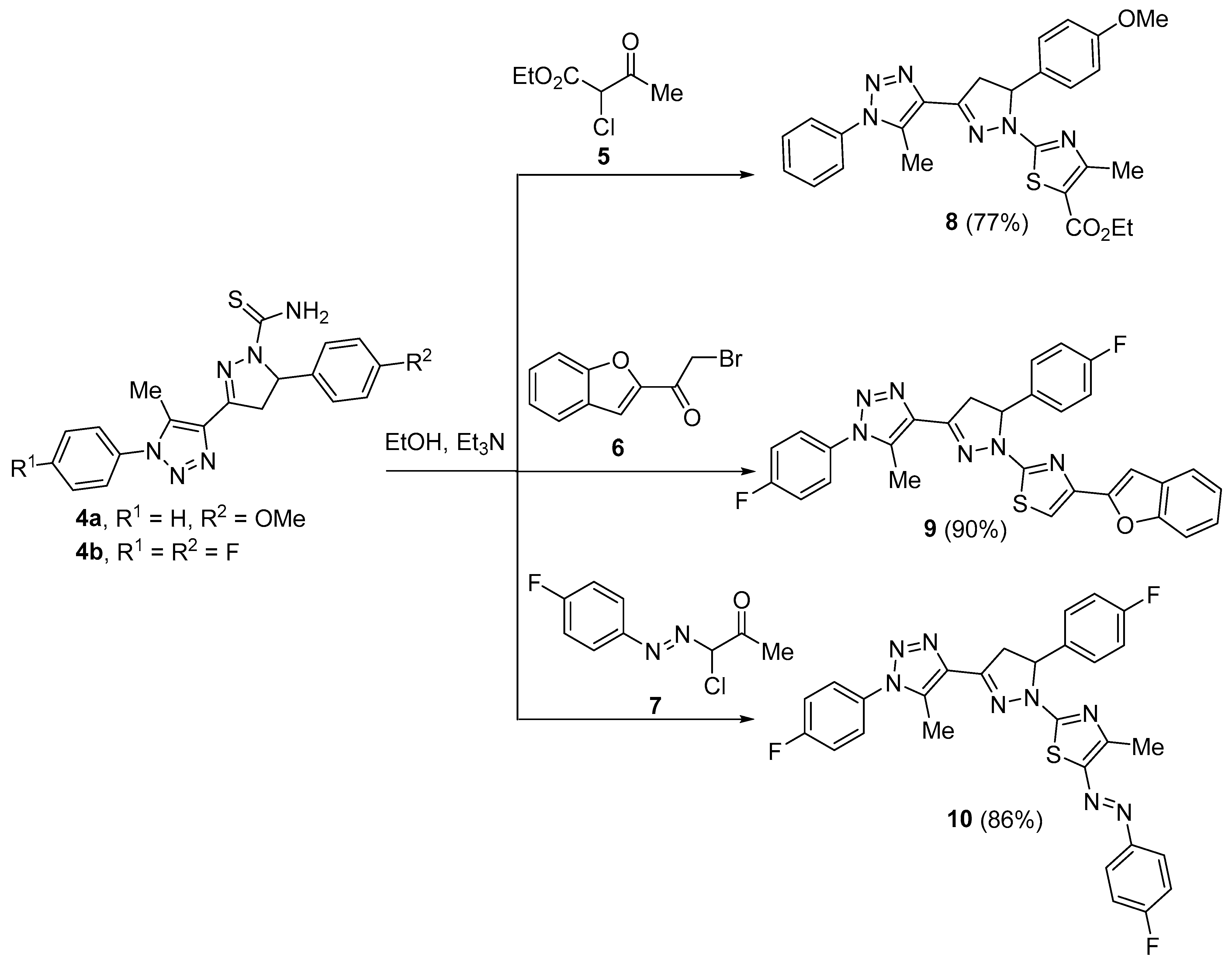


| 3a | 4a | 8 | 9 | 10 | 14 | |
|---|---|---|---|---|---|---|
| MF | C19H17N3O2 | C20H20N6OS | C26H28N6O4S | C29H20F2N6OS | C28H21F3N8S | C28H22ClFN6S |
| FW | 319.35 | 392.48 | 520.60 | 538.57 | 558.59 | 529.02 |
| T (K) | 296 (2) | 296 (2) | 296 (2) | 298 (2) | 296 (2) | 293 (2) |
| λ (Å) | 0.71073 | 1.54184 | 0.71073 | 0.71073 | 0.71073 | 0.71073 |
| System | Triclinic | Orthorhombic | Monoclinic | Triclinic | Triclinic | Monoclinic |
| Space group | Pca21 | P21/n | P21/c | |||
| A (Å) | 8.7987 (7) | 23.0527 (11) | 17.7187 (7) | 6.5793 (4) | 11.4945 (5) | 12.7331 (8) |
| b (Å) | 9.4342 (11) | 11.8887 (5) | 7.6878 (4) | 13.1589 (8) | 14.8707 (6) | 21.2977 (9) |
| c (Å) | 10.6006 (13) | 7.2229 (3) | 19.1203 (9) | 16.0368 (12) | 16.2570 (6) | 9.7424 (5) |
| α (°) | 85.681 (10) | 90 | 90 | 65.959 (6) | 96.807 (3) | 90 |
| β (°) | 72.823 (9) | 90 | 94.160 (4) | 82.697 (5) | 95.999 (4) | 105.329 (6) |
| γ (°) | 79.304 (9) | 90 | 90 | 87.701 (5) | 106.731 (4) | 90 |
| Volume (Å3) | 825.89 (16) | 1979.56 (15) | 2597.7 (2) | 1257.58 (15) | 2614.20 (19) | 2548.0 (2) |
| Z | 2 | 4 | 4 | 2 | 4 | 4 |
| D (Mg/m−3) | 1.284 | 1.317 | 1.331 | 1.422 | 1.419 | 1.379 |
| μ/(mm−1) | 0.085 | 1.641 | 0.169 | 0.180 | 0.180 | 0.269 |
| F (000) | 336 | 824 | 1096 | 556 | 1152 | 1096 |
| Crystal size (mm3) | 0.480 × 0.170 × 0.120 | 0.326 × 0.092 × 0.045 | 0.329 × 0.144 × 0.062 | 0.275 × 0.142 × 0.091 | 0.434 × 0.156 × 0.065 | 0.278 × 0.122 × 0.119 |
| Reflections collected | 6864 | 9173 | 24844 | 11051 | 25295 | 24815 |
| Independent reflections | 3935 | 3397 | 6550 | 5939 | 11910 | 6378 |
| R (int) | 0.0369 | 0.0222 | 0.0616 | 0.0341 | 0.0327 | 0.0282 |
| Goodness-of-fit on F2 | 1.057 | 1.050 | 1.030 | 1.031 | 1.012 | 1.036 |
| R1 [I > 2sigma(I)] | 0.0627 | 0.0369 | 0.0573 | 0.0538 | 0.0508 | 0.0487 |
| wR2 [I > 2sigma(I)] | 0.1639 | 0.0955 | 0.1380 | 0.1156 | 0.1233 | 0.1194 |
| R1 (all data) | 0.0928 | 0.0400 | 0.1006 | 0.0868 | 0.0945, | 0.0834 |
| wR2 (all data) | 0.1935 | 0.0989 | 0.1640 | 0.1386 | 0.1523 | 0.1395 |
| Largest diff. peak and hole (e.Å−3) | 0.231/−0.196 | 0.137/−0.170 | 0.275/−0.245 | 0.197/−0.283 | 0.221/−0.265 | 0.234/−0.316 |
Publisher’s Note: MDPI stays neutral with regard to jurisdictional claims in published maps and institutional affiliations. |
© 2022 by the authors. Licensee MDPI, Basel, Switzerland. This article is an open access article distributed under the terms and conditions of the Creative Commons Attribution (CC BY) license (https://creativecommons.org/licenses/by/4.0/).
Share and Cite
Kariuki, B.M.; Abdel-Wahab, B.F.; Mohamed, H.A.; Bekheit, M.S.; El-Hiti, G.A. Synthesis and Characterization of Novel 2-(1,2,3-Triazol-4-yl)-4,5-dihydro-1H-pyrazol-1-yl)thiazoles and 2-(4,5-Dihydro-1H-pyrazol-1-yl)-4-(1H-1,2,3-triazol-4-yl)thiazoles. Molecules 2022, 27, 8904. https://doi.org/10.3390/molecules27248904
Kariuki BM, Abdel-Wahab BF, Mohamed HA, Bekheit MS, El-Hiti GA. Synthesis and Characterization of Novel 2-(1,2,3-Triazol-4-yl)-4,5-dihydro-1H-pyrazol-1-yl)thiazoles and 2-(4,5-Dihydro-1H-pyrazol-1-yl)-4-(1H-1,2,3-triazol-4-yl)thiazoles. Molecules. 2022; 27(24):8904. https://doi.org/10.3390/molecules27248904
Chicago/Turabian StyleKariuki, Benson M., Bakr F. Abdel-Wahab, Hanan A. Mohamed, Mohamed S. Bekheit, and Gamal A. El-Hiti. 2022. "Synthesis and Characterization of Novel 2-(1,2,3-Triazol-4-yl)-4,5-dihydro-1H-pyrazol-1-yl)thiazoles and 2-(4,5-Dihydro-1H-pyrazol-1-yl)-4-(1H-1,2,3-triazol-4-yl)thiazoles" Molecules 27, no. 24: 8904. https://doi.org/10.3390/molecules27248904
APA StyleKariuki, B. M., Abdel-Wahab, B. F., Mohamed, H. A., Bekheit, M. S., & El-Hiti, G. A. (2022). Synthesis and Characterization of Novel 2-(1,2,3-Triazol-4-yl)-4,5-dihydro-1H-pyrazol-1-yl)thiazoles and 2-(4,5-Dihydro-1H-pyrazol-1-yl)-4-(1H-1,2,3-triazol-4-yl)thiazoles. Molecules, 27(24), 8904. https://doi.org/10.3390/molecules27248904










